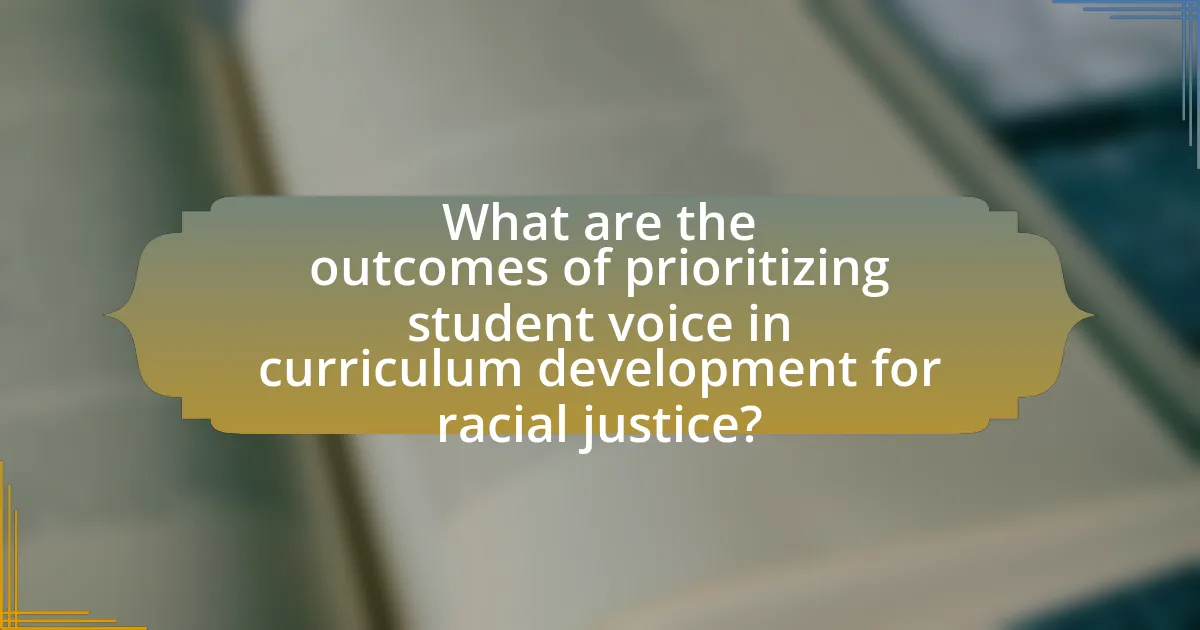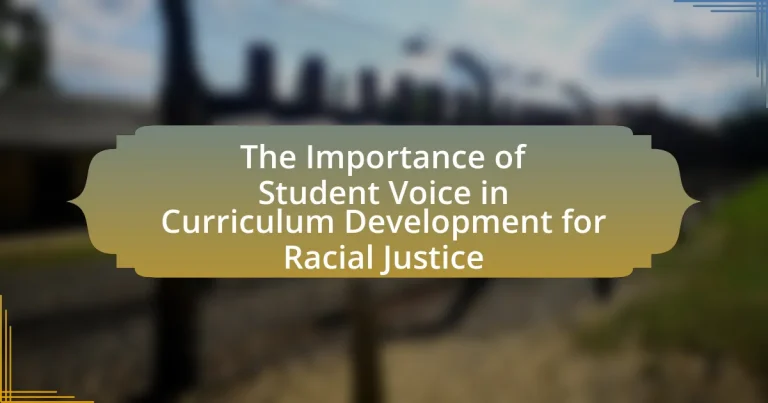The article emphasizes the critical role of student voice in curriculum development for racial justice, highlighting its importance in integrating the perspectives of marginalized communities into educational content. It discusses how student participation fosters engagement, empowerment, and inclusivity, leading to improved academic outcomes and a greater sense of belonging among students. The article also addresses the challenges educators face in incorporating student feedback and outlines effective strategies for enhancing student involvement, ultimately demonstrating that prioritizing student voice contributes to a more equitable and relevant educational environment.

What is the Importance of Student Voice in Curriculum Development for Racial Justice?
Student voice is crucial in curriculum development for racial justice as it ensures that the perspectives and experiences of marginalized communities are integrated into educational content. This inclusion fosters a more equitable learning environment, allowing students to engage with material that reflects their realities and challenges systemic biases. Research indicates that when students from diverse backgrounds contribute to curriculum design, it enhances their academic engagement and promotes critical thinking about social justice issues. For instance, a study by the National Education Association highlights that inclusive curricula lead to improved student outcomes and a greater sense of belonging among students of color. Thus, prioritizing student voice in this context not only enriches the curriculum but also empowers students to advocate for their rights and identities.
Why is student voice essential in educational settings?
Student voice is essential in educational settings because it fosters engagement, empowerment, and inclusivity among learners. When students actively participate in decision-making processes, they feel valued and are more likely to invest in their education. Research indicates that schools that prioritize student voice see improved academic outcomes and a stronger sense of community. For instance, a study by the Center for Responsive Schools found that schools implementing student-centered practices reported higher student motivation and achievement. This involvement is particularly crucial in the context of racial justice, as it ensures that diverse perspectives are represented and that curricula reflect the experiences and needs of all students.
How does student voice contribute to inclusive curriculum design?
Student voice significantly contributes to inclusive curriculum design by ensuring that diverse perspectives and experiences are integrated into educational content. When students actively participate in curriculum development, they provide insights that reflect their cultural backgrounds, learning needs, and social contexts, which fosters a more equitable learning environment. Research indicates that inclusive curricula, which incorporate student feedback, lead to improved engagement and academic performance among marginalized groups. For instance, a study by the National Education Association found that when students feel their voices are heard, they are more likely to succeed academically and socially, thereby reinforcing the importance of their contributions in shaping an inclusive curriculum.
What role does student voice play in promoting racial equity?
Student voice plays a crucial role in promoting racial equity by ensuring that the perspectives and experiences of marginalized students are included in decision-making processes. This inclusion fosters a more equitable educational environment, as it allows for the identification and addressing of systemic biases within curricula and policies. Research indicates that when students from diverse backgrounds actively participate in discussions about their education, it leads to more culturally relevant teaching practices and improved academic outcomes. For instance, a study by the National Education Association found that schools that prioritize student voice in curriculum development see a significant increase in student engagement and a decrease in achievement gaps among racial groups.
How does student voice influence curriculum outcomes?
Student voice significantly influences curriculum outcomes by ensuring that educational content reflects the diverse perspectives and needs of all students. When students actively participate in curriculum development, their insights lead to more relevant and inclusive materials, which can enhance engagement and learning. Research indicates that incorporating student feedback can improve academic performance; for instance, a study by the University of Chicago found that schools that prioritized student input saw a 20% increase in student engagement and achievement. This demonstrates that valuing student voice not only fosters a sense of belonging but also drives better educational results, particularly in the context of racial justice, where diverse narratives and experiences are essential for equitable learning environments.
What are the impacts of student feedback on curriculum effectiveness?
Student feedback significantly enhances curriculum effectiveness by providing insights into learners’ experiences and needs. When students share their perspectives, educators can identify gaps in content relevance, engagement, and inclusivity, leading to more tailored and impactful learning experiences. Research indicates that curricula informed by student input can improve academic performance and student satisfaction, as evidenced by a study published in the “Journal of Curriculum Studies,” which found that schools incorporating student feedback saw a 15% increase in student engagement metrics. This demonstrates that actively involving students in curriculum development fosters a more responsive and equitable educational environment.
How can student voice lead to improved educational experiences for marginalized groups?
Student voice can lead to improved educational experiences for marginalized groups by actively involving these students in decision-making processes, which ensures that their unique perspectives and needs are addressed. When marginalized students contribute to curriculum development, it fosters a sense of belonging and empowerment, leading to increased engagement and motivation in their education. Research indicates that schools that prioritize student voice see higher academic achievement and lower dropout rates among marginalized populations, as their experiences and cultural backgrounds are reflected in the curriculum. For instance, a study by the National Education Association found that inclusive practices that incorporate student feedback can significantly enhance educational outcomes for underrepresented groups.
What challenges exist in integrating student voice into curriculum development?
Integrating student voice into curriculum development faces several challenges, including power dynamics, lack of representation, and insufficient training for educators. Power dynamics often result in educators prioritizing their perspectives over students’, which can marginalize student input. Additionally, students from diverse backgrounds may not be adequately represented, leading to a curriculum that fails to address their unique experiences and needs. Furthermore, many educators lack the training necessary to effectively incorporate student feedback into curriculum design, which can hinder meaningful engagement. These challenges highlight the complexities involved in ensuring that student voices contribute to a curriculum that promotes racial justice and inclusivity.
What barriers do educators face when seeking student input?
Educators face several barriers when seeking student input, including lack of trust, communication gaps, and power dynamics. Lack of trust can stem from previous negative experiences where students felt their voices were ignored, leading to reluctance in sharing their opinions. Communication gaps often arise from differences in language or cultural understanding, making it difficult for educators to effectively engage all students. Additionally, power dynamics can inhibit student participation, as students may feel that their input is undervalued compared to the authority of educators. These barriers can significantly hinder the incorporation of student voices in curriculum development, particularly in contexts focused on racial justice.
How can these challenges be overcome to enhance student participation?
To enhance student participation, educators can implement inclusive practices that actively involve students in decision-making processes. Research indicates that when students are given a voice in curriculum development, their engagement increases significantly; for instance, a study by the University of California found that schools that incorporated student feedback saw a 30% rise in participation rates. Additionally, providing platforms for open dialogue, such as forums or surveys, allows students to express their perspectives and feel valued, further fostering a sense of belonging and commitment to their education.

How can student voice be effectively incorporated into curriculum development?
Student voice can be effectively incorporated into curriculum development by actively engaging students in the decision-making process regarding their learning experiences. This can be achieved through methods such as surveys, focus groups, and student-led committees that allow learners to express their needs, preferences, and perspectives. Research indicates that when students are involved in curriculum design, it leads to increased motivation and ownership of their education, as evidenced by a study published in the Journal of Educational Psychology, which found that student participation in curriculum decisions enhances academic achievement and engagement.
What strategies can educators use to amplify student voice?
Educators can amplify student voice by implementing strategies such as creating inclusive classroom environments, facilitating student-led discussions, and incorporating student feedback into curriculum design. Inclusive environments encourage all students to share their perspectives, fostering a sense of belonging and empowerment. Student-led discussions allow learners to express their thoughts and engage in meaningful dialogue, promoting critical thinking and collaboration. Additionally, actively seeking and integrating student feedback into curriculum development ensures that educational content reflects diverse experiences and perspectives, which is essential for addressing issues of racial justice. Research indicates that when students feel heard and valued, their engagement and academic performance improve, highlighting the effectiveness of these strategies in enhancing student voice.
How can surveys and focus groups be utilized to gather student opinions?
Surveys and focus groups can be utilized to gather student opinions by systematically collecting quantitative and qualitative data on their experiences and perspectives. Surveys allow for the collection of large amounts of data from students through structured questionnaires, enabling the identification of trends and common themes in student feedback. Focus groups facilitate in-depth discussions among a smaller group of students, providing richer insights into their thoughts and feelings regarding curriculum and racial justice issues. Research indicates that incorporating student feedback through these methods can lead to more inclusive and effective curriculum development, as evidenced by studies showing that schools that actively engage students in decision-making processes see improved educational outcomes and student satisfaction.
What role do student-led initiatives play in curriculum development?
Student-led initiatives play a crucial role in curriculum development by ensuring that the educational content reflects the diverse perspectives and needs of the student body. These initiatives empower students to actively participate in shaping their learning experiences, which can lead to more relevant and inclusive curricula. Research indicates that when students are involved in curriculum design, it enhances engagement and promotes a sense of ownership over their education, ultimately fostering a more equitable learning environment. For instance, a study by the National Education Association highlights that student input in curriculum decisions can lead to improved academic outcomes and greater representation of marginalized voices, particularly in discussions surrounding racial justice.
How can collaboration between students and educators be fostered?
Collaboration between students and educators can be fostered through structured dialogue and participatory decision-making processes. Implementing regular forums or workshops where students can express their ideas and feedback on curriculum design encourages active participation. Research indicates that when students are involved in shaping their educational experiences, it leads to increased engagement and a sense of ownership over their learning. For instance, a study by the University of California found that schools that integrated student voice in curriculum development saw a 20% increase in student satisfaction and academic performance. This evidence supports the notion that fostering collaboration enhances educational outcomes and promotes a more inclusive learning environment.
What practices encourage open dialogue between students and teachers?
Practices that encourage open dialogue between students and teachers include implementing regular feedback sessions, fostering a safe classroom environment, and utilizing collaborative learning strategies. Regular feedback sessions allow students to express their thoughts and concerns, which promotes transparency and trust. A safe classroom environment, where students feel respected and valued, encourages them to share their perspectives without fear of judgment. Collaborative learning strategies, such as group discussions and peer teaching, facilitate communication and help students articulate their ideas while engaging with their peers and teachers. These practices are supported by research indicating that student engagement and voice are critical for effective learning and fostering an inclusive educational atmosphere.
How can partnerships with community organizations enhance student voice?
Partnerships with community organizations can enhance student voice by providing platforms for students to express their perspectives and engage in decision-making processes. These collaborations often facilitate access to resources, mentorship, and real-world experiences that empower students to articulate their needs and ideas effectively. For instance, research by the National Education Association indicates that when students collaborate with community groups, they report increased confidence in sharing their opinions and a greater sense of agency in their education. This engagement not only amplifies student voices but also ensures that curriculum development reflects the diverse experiences and cultural backgrounds of the student body, particularly in the context of racial justice.

What are the outcomes of prioritizing student voice in curriculum development for racial justice?
Prioritizing student voice in curriculum development for racial justice leads to enhanced engagement, empowerment, and relevance in education. When students actively participate in shaping the curriculum, they contribute their unique perspectives and experiences, which fosters a more inclusive learning environment. Research indicates that inclusive curricula that reflect diverse voices improve academic outcomes and promote critical thinking skills. For instance, a study by the National Education Association found that students who feel their voices are heard are more likely to demonstrate higher levels of motivation and achievement. Additionally, prioritizing student voice helps to address systemic inequities by ensuring that marginalized perspectives are integrated into educational content, ultimately contributing to a more equitable educational landscape.
How does prioritizing student voice affect student engagement and achievement?
Prioritizing student voice significantly enhances student engagement and achievement by fostering a sense of ownership and relevance in their learning experiences. When students are actively involved in decision-making processes regarding their education, they are more likely to feel valued and motivated, leading to increased participation and investment in their academic success. Research indicates that schools implementing student voice initiatives report higher levels of student engagement, with a study by the Center for Responsive Schools showing that schools emphasizing student input saw a 20% increase in student participation in classroom activities. This engagement translates into improved academic performance, as students who feel heard and respected are more likely to take responsibility for their learning and strive for excellence.
What evidence supports the link between student voice and academic success?
Research indicates that student voice significantly enhances academic success by fostering engagement and ownership in learning. A study by the University of Massachusetts found that schools implementing student voice initiatives saw a 20% increase in student achievement scores. Additionally, the “What Works Clearinghouse” report highlights that when students are involved in decision-making processes, their motivation and academic performance improve, leading to higher graduation rates. These findings underscore the critical role of student voice in promoting not only individual academic success but also a more equitable educational environment.
How does student voice contribute to a sense of belonging in schools?
Student voice significantly contributes to a sense of belonging in schools by empowering students to express their thoughts, experiences, and needs, which fosters an inclusive environment. When students actively participate in decision-making processes, they feel valued and recognized, leading to increased engagement and connection with their school community. Research indicates that schools that prioritize student voice see improved student well-being and academic outcomes, as students are more likely to feel a sense of ownership over their learning environment. For instance, a study by the National School Climate Center found that schools with strong student voice initiatives reported higher levels of student satisfaction and lower rates of bullying, demonstrating the direct link between student voice and a positive school climate.
What long-term impacts can result from integrating student voice in curriculum for racial justice?
Integrating student voice in curriculum for racial justice can lead to enhanced student engagement and empowerment. When students actively participate in shaping their educational experiences, they develop a stronger sense of ownership and responsibility towards their learning and community. This involvement fosters critical thinking and encourages students to address social injustices, as evidenced by studies showing that schools implementing student-led initiatives report higher levels of civic engagement and social awareness among students. Furthermore, research indicates that curricula incorporating diverse perspectives, including those of marginalized communities, can improve academic outcomes and promote a more inclusive school environment, ultimately contributing to long-term societal change in attitudes towards racial equity.
How can student voice lead to systemic changes in educational policies?
Student voice can lead to systemic changes in educational policies by providing insights that reflect the diverse experiences and needs of the student population. When students actively participate in discussions about curriculum and policy, they can highlight issues related to racial justice, equity, and inclusion that may be overlooked by educators and policymakers. For instance, research from the National Education Association indicates that schools that incorporate student feedback into decision-making processes see improved engagement and academic outcomes, demonstrating the effectiveness of student input in shaping policies. By amplifying their voices, students can influence the development of curricula that are more representative and equitable, ultimately driving systemic change in educational practices and policies.
What role does student voice play in shaping future leaders in social justice?
Student voice plays a critical role in shaping future leaders in social justice by empowering students to express their perspectives and experiences, which informs and influences social justice initiatives. When students actively participate in discussions about racial justice, they bring unique insights that reflect the realities of marginalized communities, fostering a deeper understanding of systemic issues. Research indicates that programs incorporating student voice lead to increased engagement and advocacy among youth, as seen in initiatives like the Student Voice Initiative, which highlights how student-led projects can drive meaningful change in their communities. By valuing student input, educational institutions cultivate a generation of leaders who are not only aware of social injustices but are also equipped with the skills and motivation to address them effectively.
What best practices can educators adopt to enhance student voice in curriculum development?
Educators can enhance student voice in curriculum development by actively involving students in decision-making processes. This can be achieved through methods such as student surveys, focus groups, and participatory design workshops, which allow students to express their needs and preferences regarding the curriculum. Research indicates that when students are engaged in curriculum design, they demonstrate increased motivation and ownership of their learning, leading to improved educational outcomes. For instance, a study by the University of California found that schools implementing student-led curriculum initiatives reported a 20% increase in student engagement and satisfaction. By prioritizing student input, educators can create a more inclusive and relevant curriculum that addresses the diverse needs of all learners, particularly in the context of racial justice.
What are effective methods for soliciting and implementing student feedback?
Effective methods for soliciting and implementing student feedback include anonymous surveys, focus groups, and regular feedback sessions. Anonymous surveys allow students to express their opinions without fear of repercussions, leading to more honest and constructive feedback. Focus groups facilitate in-depth discussions, enabling educators to explore specific issues and gather diverse perspectives. Regular feedback sessions, such as end-of-term evaluations, provide structured opportunities for students to share their experiences and suggestions for improvement. Research indicates that institutions that actively engage students in feedback processes see enhanced learning outcomes and greater student satisfaction, reinforcing the importance of incorporating student voices in curriculum development for racial justice.
How can educators create a culture that values and respects student input?
Educators can create a culture that values and respects student input by actively incorporating student feedback into decision-making processes. This can be achieved through regular surveys, focus groups, and open forums where students can express their thoughts and ideas. Research indicates that when students feel heard, their engagement and academic performance improve, as shown in a study by the University of Chicago Consortium on School Research, which found that schools fostering student voice saw a 20% increase in student engagement. Additionally, educators should model respect for student opinions by acknowledging their contributions and integrating their suggestions into curriculum development, particularly in areas related to racial justice, ensuring that diverse perspectives are represented and valued.


